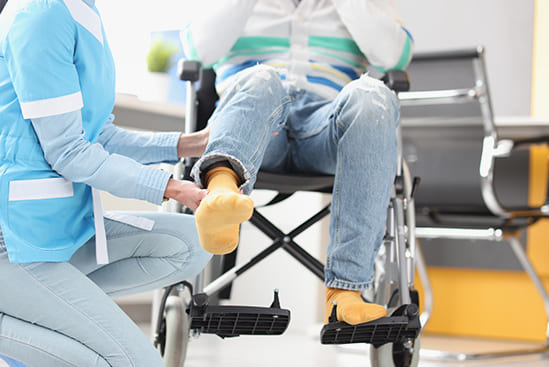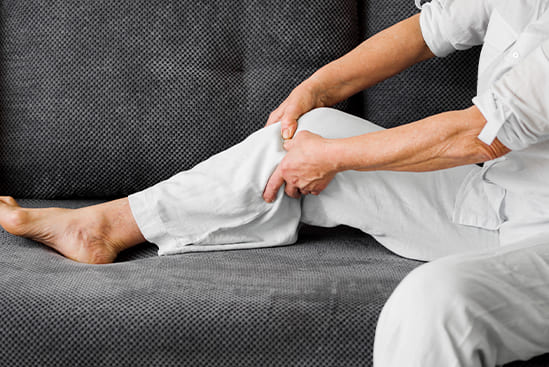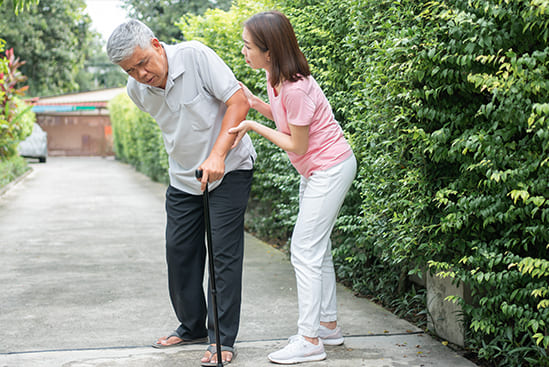
Scoliosis & Postural Abnormalities
Physiotherapy for Slip Disc | Avoid Surgery Today
A slip disc, also known as a herniated or prolapsed disc, is a common spinal condition that can cause severe pain and discomfort. While surgery might seem like the only solution, physiotherapy has proven to be an effective, non-invasive approach to managing and even healing slip disc problems. In this article, we will explore how physiotherapy can help in treating a slip disc, the techniques used, and why it is a preferred alternative to surgery.
Understanding Slip Disc
The human spine is made up of vertebrae, which are bony structures stacked on top of each other, forming a column. Between these vertebrae, soft, gel-like discs act as shock absorbers, preventing friction and providing flexibility to the spine.
However, these discs may sometimes shift from their original position, causing the inner tissue to protrude toward the surrounding nerves. This condition, commonly referred to as a slipped, ruptured, prolapsed, or herniated disc, can lead to pain and discomfort.
Causes of Slip Disc
A slipped disc can occur due to various reasons, including:
- Natural wear and tear of the discs over time, leading to degeneration and reduced elasticity.
- Engaging in strenuous exercises or intense physical activities.
- Lifting heavy objects improperly, leading to excessive strain on the spine.
- Leading a sedentary lifestyle or being overweight, which increases pressure on the spinal discs.
Symptoms of Slip Disc
A slipped disc can cause a variety of symptoms, depending on the affected area of the spine. Some common symptoms include:
- Sharp pain in the lower back or neck
- Numbness or tingling sensations in the arms or legs
- Muscle weakness
- Difficulty in movement or standing for long periods
- Pain that worsens with movement or sitting
If left untreated, a slip disc can lead to chronic pain and long-term mobility issues. This is why early intervention with physiotherapy is crucial.
Why Choose Physiotherapy Over Surgery?
While surgery may be necessary in severe cases, it comes with risks, long recovery times, and potential complications. Physiotherapy offers a safer alternative with numerous benefits:
- Non-invasive treatment: No surgical procedures or anesthesia required.
- Cost-effective: Physiotherapy is significantly more affordable than surgery.
- Minimal recovery time: Patients can continue their daily activities while undergoing therapy.
- Addresses root causes: Unlike painkillers, physiotherapy treats the underlying issue rather than just masking the pain.
- Reduced risk of recurrence: Strengthening exercises and posture correction help prevent future disc problems.
How Physiotherapy Helps in Treating Slip Disc
Physiotherapy is a non-invasive treatment that focuses on relieving pain, strengthening muscles, and improving mobility. It is designed to address the root cause of the problem rather than just managing symptoms. Here’s how physiotherapy can help:
1. Pain Management
Physiotherapists use various pain relief techniques such as:
- Manual Therapy: Hands-on techniques like myofascial release, deep transverse friction, joint mobilization, and stretching help reduce pain and improve flexibility.
- Electrotherapy: Techniques like TENS (Transcutaneous Electrical Nerve Stimulation) and ultrasound therapy help in reducing pain and inflammation.
- Heat and Cold Therapy:
- Heat Therapy: Applied for chronic injuries to improve blood circulation and accelerate healing. This can be done using hot packs, warm towels, wraps, or gels.
- Cold Therapy (Cryotherapy): Used for acute injuries to reduce swelling, inflammation, and numb pain. It can be applied using ice packs, cold sprays, compression wraps, or gels.
2. Strengthening and Stabilization
Weak muscles around the spine contribute to poor posture and spinal instability. Physiotherapy includes exercises that:
- Strengthen core muscles to provide better support to the spine.
- Improve flexibility in the spine and surrounding muscles.
- Enhance posture to prevent further injuries.
Core stability is a crucial aspect of strengthening. The core muscles, including the abdominal, spinal, pelvic floor, and hip muscles, work together to maintain stability in both stationary and dynamic positions. These muscles act like a corset around the trunk, ensuring that movements originate from a strong foundation. Physiotherapy includes targeted core stability exercises to improve the efficiency and strength of these muscles, thereby preventing further complications.
3. Postural Realignment
Ensuring proper spinal alignment helps to prevent excessive strain on the affected disc and surrounding muscles. Physiotherapists focus on:
- Postural Assessment: Identifying tight or weak muscles, joint stiffness, or hypermobility that may contribute to poor posture.
- Postural Advice: Providing personalized recommendations for correct sitting and standing positions, movement techniques, and work-related postural adjustments.
- Postural Exercises: Strengthening weak muscles, stretching tight muscles, and improving joint stability for better posture and pain relief.
4. Myofascial Release & Trigger Point Therapy
- Myofascial Release: The fascia, a connective tissue covering muscles, can become tight and restricted after an injury. Physiotherapists apply gentle, sustained pressure to release tension and restore movement.
- Trigger Point Therapy: Localized muscle tightness (trigger points) can cause pain and stiffness. Deep tissue massage, applied pressure, and stretching techniques help alleviate discomfort and improve range of motion.
5. Electrotherapy
Electrotherapy is used to accelerate the healing process of soft tissues. Physiotherapists use different types of electrotherapy, including:
- Ultrasound Therapy: Uses sound waves to promote tissue healing and reduce inflammation.
- Interferential Stimulation: Helps manage pain by delivering electrical impulses to affected areas.
- TENS (Transcutaneous Electrical Nerve Stimulation): Blocks pain signals to the brain and stimulates endorphin release.
- PSWD (Pulsed Short-Wave Diathermy): Enhances deep tissue healing through electromagnetic energy.
6. Stretching Exercises
Physiotherapists often include stretching exercises in treatment plans to address muscle tightness and restricted movement. Stretching extends muscles beyond their normal range to increase flexibility and reduce tension.
- Static Stretching: Holding a position for about 30 seconds to lengthen muscles.
- Dynamic Stretching: Active movements that improve flexibility and prepare muscles for activity.
Conclusion
Physiotherapy is a highly effective treatment for a slipped disc, offering long-term pain relief and improved mobility without the need for surgery. Through pain management techniques, strengthening exercises, posture correction, and lifestyle modifications, physiotherapy not only heals the condition but also prevents future spinal issues.
At Synapse Physiotherapy, we specialize in personalized physiotherapy treatments designed to help you recover quickly and effectively. If you or a loved one are struggling with a slip disc, consult our expert physiotherapists today to start a customized treatment plan and regain a pain-free, active life.
Tags :

Back & Neck Pain
Conditions such as stiffness, postural abnormalities and muscle overuse from prolonged desk work at the office or home is more prevalent than most would think. We provide the necessary tools to fix you up and educate you on ergonomics which can unload unnecessary stress.
- Spine & Core Rehabilitation
- Strength & Conditioning Programme
- Pain Management
- Biomechanical Assessment
- Sports Physiotherapy
- Group Class

Sports Injuries
Rolled ankles, jarred knees, impinged shoulders are few conditions in the plethora of sports injuries which can hamper performance and limit our enjoyment of sports. Physiotherapy not only treats the symptoms of these conditions but propels your overall fitness to greater heights.
- Strength & Conditioning Programme
- Pain Management
- Biomechanical Assessment
- Sports Physiotherapy
- Shockwave Therapy
- Group Class

Work Desk Injuries
Conditions such as stiffness, postural abnormalities and muscle overuse from prolonged desk work at the office or home is more prevalent than most would think. We provide the necessary tools to fix you up and educate you on ergonomics which can unload unnecessary stress.

Pre-Post-Surgical Conditions
Surgery involves going through preparation both before and after. Physiotherapists play a vital role in getting your body ready for surgeries with circulatory, breathing and strengthening exercises. After the procedure, let us be there for your recovery and rehabilitation, taking it one step at a time.

Scoliosis & Postural Abnormalities
The way we stand, sit, walk and sleep has influence over our posture and the overall balance of muscles controlling its alignment. A comprehensive screening can be done by our physiotherapists to detect abnormalities, which we will aid in correcting.

Neurological Conditions
Neurological disabilities such as stroke, nerve compression and neuropathies can be barriers for patients to live life to its fullest. We at Synapse are committed to help you overcome these hurdles by ensuring functional mobility and quality of life is at its optimum by providing the right treatment and exercises.

Osteoarthritis & Rheumatism
Joint degeneration and inflammation happens as the human body grows older, but that does not mean our way of life degenerates as well. Relief your joint pains with a joint effort together with your physiotherapist, who will provide pain-relief treatments and prescribe exercises for your wellbeing.

Conditions Relating To Elderly
Common conditions in the older age population include hips & knee pain, back & neck pain, osteoarthritis, rheumatism, fear of falling and many more. Aging and degeneration of bodily function is inevitable, but here at Synapse, we will help you live the best of your life.

Home Physiotherapy
We understand that some conditions or injuries can make it difficult to receive rehabilitation at our clinic be it mobility or transportation issues. Our objective is to provide you with the same high-quality physiotherapy services at home that you would receive in-clinic.
